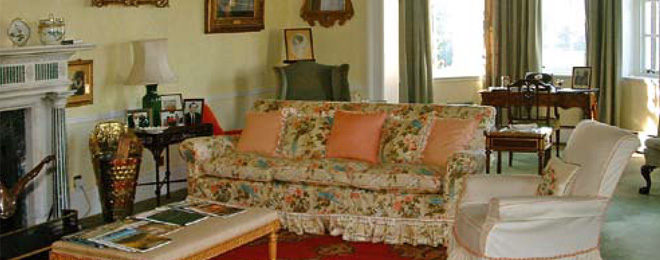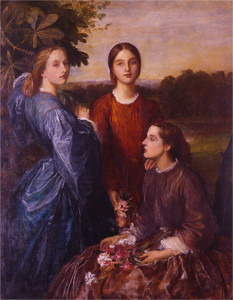
Returning through the library and the Ante Room, which is also lined with bookcases, the drawing room is reached. It fills the eastern of the twin Georgian pavilions on the south front and is a well-proportioned room with a high coved ceiling. Like the State Bedroom, it also has a canted bay with Venetian window. The fine Eighteenth Century marble chimneypiece was brought by the 12th Marquis from Crailing House, nearby.
The eighteenth and Nineteenth Century portraits in the drawing room include some of the most distinguished in the house. Starting on the West wall, to the right of the door and working round the room anti-clockwise, they are: The 4th Duke of Rutland by Sir Joshua Reynolds, Lord Newbattle, later 6th Marquis of Lothian in ‘van Dyck dress’ by Revd. Matthew William Peters, painted in 1778. Peters specialized in sentimental pictures of children and angels. On the fireplace wall is a very fine portrait of the 6th Marquis of Lothian in later life by Sir Henry Raeburn. The 6th Marquis was Lord Lieutenant of Midlothian and Roxburghshire, and began the improvements and tree planting that transformed Monteviot into a principal family seat in the Nineteenth Century. He caused a scandal by running off with the estranged wife of Lord Belmore and marrying her after divorce. She was the eldest daughter of the last Earl of Buckinghamshire whose possessions, including the Blickling estate in Norfolk were eventually to pass to the Lothians when they were inherited by the 7th Marquis in 1850, though in the short term Lord Buckinghamshire left them to his younger daughter, Lady Suffield, for life.
The pair of flower paintings are by Ludovic Stern and the two small oils of the 7th Marquis, who commissioned Blore to rebuild Monteviot as a large mansion, and his wife Cecil Talbot, daughter of the Earl of Shrewsbury, are by Sir Francis Grant. Over the chimneypiece is an attractive group by Benjamin West of Mrs. West and their son Raphael. The other portrait on the fireplace wall is of Elizabeth Fortescue, the wife of the 5th Marquis, by Reynolds.

Lady Lothian and her sisters, Lady Adelaide Talbot (Countess Brownlow) and Lady Gertrude Talbot (Countess of Pembroke)
On the north wall is a characteristic portrait of a Young Man in Black by Annibale Carracci and, in the centre, a masterpiece by G. F. Watts of the three Talbot sisters, daughters of the Earl of Shrewsbury, including Constance, wife of the 8th Marquis. Next to it is a fine study of the red-bearded Marquis himself, also by Watts. A brilliant scholar who won a double first at Oxford, the 8th Marquis succumbed to a serious illness and died young. The furniture in the Drawing Room also comprises pieces of high quality. These include the two little French tables besides the sofas. That in the Louis XVI style nearer the window has a top with a square Sevres plaque which forms a reading stand, and is stamped by Edward Baldock, the famous furniture broker who supplied much at Abbotsford for Walter Scott; that nearer the door has still-life marquetry and is stamped by J.-L. Faizelot-Delorme. There is also a fine large Louis XV Kingwood writing table by Adrien Fleury under the Watts portrait, and flanking the chimneypiece a pair of Chippendale style mahogany tea tables. In the glazed cupboard is a part of a Derby botanical dessert service brilliantly painted with individual flowers by William Pegg, a Quaker and talented botanical artist much used by the Derby factory. Under the Reynolds of Elizabeth Fortescue is an ivory inlaid Renaissance coffer dated 1565 on a stand, now used to store CDs, for, like all the main apartments at Monteviot, the drawing room is a much used and comfortable family room.
